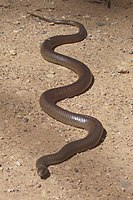
Photo from wikipedia
BACKGROUND This report describes 17 cases of red-bellied black snake envenomation (RBBS; Pseudechis porphyriacus) in dogs in south-eastern Queensland. Patients were prospectively enrolled for the treatment with a new tiger-brown… Click to show full abstract
BACKGROUND This report describes 17 cases of red-bellied black snake envenomation (RBBS; Pseudechis porphyriacus) in dogs in south-eastern Queensland. Patients were prospectively enrolled for the treatment with a new tiger-brown snake antivenom 8000 units, (TBAV; Padula Serums Pty Ltd, VIC, Australia). CASE REPORT Clinical diagnosis of RBBS envenomation was made by either snake venom detection kit, snake identification using scale counting, or owner observed dog-snake interaction in patients with clinical signs of envenomation. An RBBS venom antigen sandwich ELISA was used to retrospectively quantify venom levels in frozen serum and urine. Mechanical ventilation was required in 11% (2/17) patients, whole blood transfusion in 12% (2/17), tissue swelling at the bite site occurred in 53% (9/17) and facial palsy in 12% (2/17). One dog was euthanised, and overall, 94% (16/17) survived to hospital discharge. Clinicopathological changes pre-TBAV included variable haemolysis, increased CK, pigmenturia and mildly prolonged active clotting time with a median of 134 s (n = 13, range 91-206 s). Haematological profiles post envenomation revealed anaemia (6/6) and spherocytosis (5/5), which resolved without the use of corticosteroids. Pre-TBAV, median RBBS venom antigen concentration was 22.6 ng/mL (n = 15, range 2-128) in serum and 58 ng/mL (range 1-452) in urine; RBBS venom antigen was undetectable in serum post-TBAV in all patients. CONCLUSION Some RBBS envenomed dogs required, critical care including mechanical ventilation, blood transfusion, additional antivenom and prolonged hospitalisation. TBAV was effective with excellent prognosis despite stated specificity for tiger and brown snake.
Journal Title: Australian veterinary journal
Year Published: 2020
Link to full text (if available)
Share on Social Media: Sign Up to like & get
recommendations!